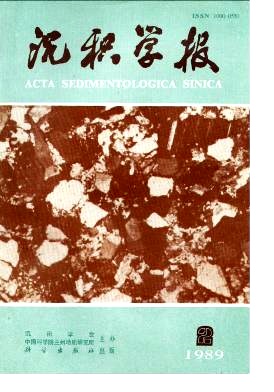Jin Rougn. A DEEP WATER SEDIMENTARY CRITERIA——"KNOTTY NODULE" AND ORIGIN[J]. Acta Sedimentologica Sinica, 1989, 7(2): 51-60.
| Citation:
|
Jin Rougn. A DEEP WATER SEDIMENTARY CRITERIA——"KNOTTY NODULE" AND ORIGIN[J]. Acta Sedimentologica Sinica, 1989, 7(2): 51-60.
|
A DEEP WATER SEDIMENTARY CRITERIA——"KNOTTY NODULE" AND ORIGIN
- Received Date: 1986-12-12
- Publish Date:
1989-06-10
-
Abstract
The " knotty nodule" of Dalong Formation of Late Permian in Northern Sichuan and Sorthern Shaanxi Province are composed of siliceous-rich nodules and clay-rich matrix. They may have two differ sedimentary sequence: One is type of Northern Sichuan, which is mainly distributed to Northern Jiangyou, Guangyuan, and Western Wangcang region in Northern Sichuan: The other is type of Sorthern Shaanri, which is distributed to Xixiang region in Sorthern Shaanxi (Fig.l). The "knotty nodule" and the surrounding rocks are dark colored thin to medium-thin bedding micritic limestone, siliceous micritic limestone, radiolarias siliceous rock, siliceous rock, argillaceous limestone and shale (or mudstone) etc. with horizontal and rhythms bedding, part rich in organic ous materials and pyrites (or nodule). In the "knotty nodule, " the biota is characterized as abundance planktonic faunas such as radiolarias, ammonoids, condonts and thin-shelled brachiopods and a few foraminifers, ostracods, calcisphers and sponge- spiculite etc. According to sedimentary characterxs and faunal studies, the" knotty nodule" and the surrounding rocks may suggest deposition in outer shelf to basin environment, with waterdepth in the 100 to 200m or 300 to 500m range and under normal salinities. In accordance with origin and texture, the"knotty nodule" may be divided into three types, e.g. knotty nodule (discontinuous), continuous knotty nodule and flaser knotty nodule (or flaser structures). The knotty nodule is mainly distributed to upper part of Dalong Formation in Xixiang, Shaanxi Province.It is composed of dispersion nodules and rich in lime-muddy matrix. These nodules arc dark grey siliceous-bering micritic limestone, and usually are irregular and lenticle nodules. The continuous knotty nodule is distributed to upper and lower part of Dalong Formation in Guangyuan, Sichuan Province. They are silica-rich siliceous micritic limestone, radiolarias siliceous rock, in which the nodules preceded to the interlocking coalescence to nodules layer of semi-continuous or continuous. In general, the continuous knotty nodules inerleaved with more distortional siliceous shale layers and exhibit a certain rhythm structure. The flaser knotty nodule consist of small lime-siliceous ellipsoidal bodies or lenses (or flaser nodule) surrounded by siliceous- rich solution seams. The most flaser nodules are the comparatively high degree of preferred orientation, and nearly parallel to bedding. In many cases, both flaser nodules and the adjacent solution seams have abundent radiolarias. Within these nodules, the radiolarias are random bioturbated fabric, that it was locked in place by early cementation, whereas in the surrounding solution seams of nodules have the preferred alignment of radiolarias elongate grams. These are formed by the surrounding matrix remained unlithification during burial and may even have flowe plasticully around the hardened nodule during compaction. The solution seams may cut across primary depositional features such as bedding planes and omission surface, and they cut and truncate burrows. In many flaser knotty nodules, the solution seams form a secondary matrix to nodules, and seams are distorted around or cemented nodules. Carbon and oxygen isotope data (table 2, Fig. 4) indicated that the " knotty nodule" and the surrounding rocks were formed by submarine diagenesis cementation, which were in the direction of equilibrium with ambient colder bottom water than the surrounding sediment. This data is very similar to carbon and oxygen isotopes of the nodule, chalk nodule and hardground by the Cretaceous-Tertiary of the Caribbean (Deep Sea Drilling Project) and by the Cretaceous of the Northwest-European (Fig. 5) As noted above, from the characters of sedimentary, carbon and oxygen isotopes in the "knotty nodule" lead to the following conclusions about their origin: 1, The knotty nodule produced by sea floor early diagentic cementation, in which the pause in pelagic sedimention and closer to the sediment-water interface. 2, The continuous knott
-
References
|
[1]
|
(1) 李子舜等1986,中生代一古生代之交的生物绝灭和地质事件一四川广元上寺二叠系一三叠系界线和事件的初步研究。地质学报,第60卷、第1期.
(2) Kennedy. W.J.. and Garrison, R.E., 1975, Sedimentology. V.22, p.311-386.
(3) Garrison, R.E., and Kennedy, W,J., 1977, Sedimentary Geology. V.19. p.107-137.
(4) Jenkyns, H.C., 1974, Origin of red nodular limestones (Ammonitico Rosso, Knollenkalke) in the Mediterranean Jurassic: a diagenetic model. in Hsu. K.J., and Jenkyns, H.C., eds., Pelagic sedi-ments on land and under the sea. Int. Assoc. Sedimentologists Spec. Pub. N. 1,p.249-267.
(5) Tucker, M. E.,1974. Sedimentology of Palaeozoic pelagic limestones: the Devonian Griotte(southern France) and Cepha lopodenkalk (Germany),in Hsu.K.J., and Jenkyns, H.C., eds.. Pelagic sediments on land and under the sea. Int. Assoc. Sedimentologists Spec. Pul N.1, p.71-90.
(6) Mullins, H.T.. et al.. 1980. Jour. Sed. Petrology, V.50, N.l. p.117-132.
(7) Muller. J.. and Fabricius, F.,1974. Magnesiam-Calcite nodular in the Ionian deepsea: Anactualistic model for the formation of some nodular limestones. in Hsu, K.J., and Jenkyns, H.C., eds.,
Pelagic sediments on land and under the sea; Int. Assoc. Sedimentologists Spec. Pub. N.1,p.235-247.
(8) Schlager, W., and James, N.P., 1978, Sedimentology, V.25, p.675-702
(9) Millman, J. D.,and Mueller, J.,1977. Characteristics and genesis of shallow-water and
deep-sea limestones. in Anderson, N.R.,and Malahoff, A.,eds.,The fate of fossil fuel CO in the
oceans: New York, Plenum Press.
(10) Kukal, Z., 1975, California Mineralogists Geologiss, V.20. p.359-368.
(11) Hopkins. J.C., 1977, Production of Coreslope breccia by differential submarine cementation and
downslope displacement of carbonate sands. Miette and Ancient wall buildups. Devonian. Canada: Soc.
Econ. Paleontologists Mineralogists Spec. Pub. N.25, p.155-170.
(12) Weyl, P.K., 1959, J. Geophys. Res., 64: p.2001-2025. |
-
-
Proportional views

-






 DownLoad:
DownLoad: